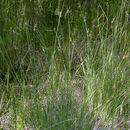Comprehensive Description
provided by North American Flora
Carex serratodens W. Boott, in S. Wats. Bot. Calif
2:245. 1880.
Carex bifida Boott; Olney, Proc. Am. Acad. 7: 394. 1868. (Type from Salinas Valley, south of Monterey, California.) Not C. bifida Roth; Steud. Nom. ed. 1. 155. 1821.
Carex aequa C. B. Clarke, Kew Bull. Add. Ser. 8: 86. 1908. (Type from San Mateo County, California.)
Loosely cespitose with short, ascending stolons, the culms 3-12 dm. high, slender, sharply triangular, smooth or roughened immediately beneath spikes, papillose, exceeding the leaves, aphyllopodic and strongly purplish-tinged at base, the basal sheaths breaking and becoming filamentose; sterile shoots strongly phyllopodic, very conspicuous; leaves with well-developed blades 2-5 to a fertile culm, clustered on lower fourth, the blades 1-6 dm. long, 1.75-4 mm. wide, flat, pale-green, papillose, slender, long-attenuate, roughened towards apex, not septatenodulose, the sheaths very thin and dull-white-hyaline or yellowish-brown-tinged and reddotted ventrally, the ligule strongly red-dotted, as long as wide; terminal spike staminate or gynaecandrous, slightly peduncled or nearly sessile, linear, 1.5-3 cm. long, 3-4.5 mm. wide, the scales oblong-obovate, from roughly short mucronate to obtuse, reddish-brown with lighter center and slightly hyaline apex; pistillate spikes 2-5, the lower 1 or 2 more or less separate, the others closely approximate, erect, sessile or the lowest slightly peduncled, oblong, 6-18 mm. long, 5-8 mm. wide, densely flowered, containing 20-40 ascending and at length spreading or squarrose perigynia in many rows; lowest bract leaflet-like, erect, from shorter than to exceeding culm, scarcely sheathing, purplish-tinged at base; the other bracts much reduced; scales ovate, acute to shortly rough-mucronate, somewhat narrower and slightly shorter than perigynia, reddish-brown with lighter center; perigynia oblong-ovate or ovate, flattened-triangular in cross-section, 3-5 mm. long, 1.5-2 mm. wide, many (about 10)nerved, light-green, purplish-dotted, puncticulate, the walls thin, round-contracted and sessile at base, rather abruptly tapering at apex into the slender bidentate rough beak 0.5-1 mm. long, the notch narrow, the teeth erect, minute, hispidulous and purplish-tinged within; achenes obtusely triangular, obovoid, 2 mm. long, 1.5 mm. wide, loosely enveloped, in lower half of perigynium, short-stipitate, abruptly slenderly apiculate, jointed with the straight slender style; stigmas 3, reddish-brown, slender, short.
Type locality: California, without locality or collector being given.
Distribution: Open places, Jackson County, Oregon, and southward in California, mostly in the Coast Ranges, to San Bernardino County. (Specimens examined from range as given.)
- bibliographic citation
- Kenneth Kent Mackenzie. 1935. (POALES); CYPERACEAE; CARICEAE. North American flora. vol 18(6). New York Botanical Garden, New York, NY

